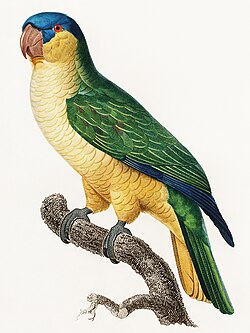Biology:Black-lored parrot
| Black-lored parrot | |
|---|---|

| |
| Scientific classification | |
| Domain: | Eukaryota |
| Kingdom: | Animalia |
| Phylum: | Chordata |
| Class: | Aves |
| Order: | Psittaciformes |
| Family: | Psittaculidae |
| Genus: | Tanygnathus |
| Species: | T. gramineus
|
| Binomial name | |
| Tanygnathus gramineus (Gmelin, JF, 1788)
| |
The black-lored parrot (Tanygnathus gramineus) also known as the Buru green parrot, is a parrot endemic to the Indonesian island of Buru. It is a 40 cm (16 in) long green parrot with black lores, and a turquoise crown. Males have red beaks, and females are gray-brown. The singing is high pitched and more protracted as compared to similar species, such as great-billed parrot.[citation needed]
Taxonomy
The black-lored parrot was described in 1779 by the French polymath, the Comte de Buffon in his Histoire Naturelle des Oiseaux.[2] He published a hand-coloured illustration in a separate publication.[3] When in 1788 the German naturalist Johann Friedrich Gmelin revised and expanded Carl Linnaeus's Systema Naturae, he included the black-lored parrot with a short description, coined the binomial name Psittacus gramineus and cited Buffon's works.[4] The black-lored parrot is now one of four species placed in the genus Tanygnathus that was introduced by the German naturalist Johann Wagler in 1832.[5][6] The name Tanygnathus combines the Ancient Greek words tanuō "to stretch out" and gnathos "jaw". The specific epithet gramineus is from Latin and means "grasslike" or "green".[7]
Distribution and habitat
The bird is rare and either fully or partly nocturnal, and therefore is poorly described. Its behaviour was reported by the Dutch ornithologist Hendrik Cornelis Siebers (in 1930.[8][9] The bird predominantly occupies the central, more elevated part of the island of Buru, Indonesia, where it was reported at the settlements of Gunung Tagalago, Wa Temun and Kunturun at elevations of 700–1100 meters (2,300–3,000 ft), as well on the southern lowlands at Fakal, Ehu and Leksula. There was one observation of these parrots near the Kayeli Bay at the eastern shores of Buru. More recent observations were made off the northern (Waflia) and northwestern (Wamlana) shores. The voice of the black-lored parrot was frequently heard at Kunturun, mostly 1–7 hours after the sunset, where the locals called the bird "kakatua ol’biru", meaning blue-headed parrot. However, it was caught during the day with slingshots in fruit trees suggesting that its activity is not purely nocturnal. Migration is relatively weak and there are only few reports of the parrots flying up and down hill at high altitudes overnight, as judged from their voices.[1][10]
The population density of black-lored parrot is estimated as 1.3–19 birds/km2.[1] These birds apparently favor high-altitude forests which on Buru have areas of 1,789 km2 above 900 m, and 872 km2 above 1,200 m. Those forests are relatively untouched by logging which affects coastal areas. Hunting or capturing of these birds by locals is rather limited, and there is only one report of the locals selling a captured black-lored parrot at a market of the nearby Ambon Island in 1998.[10]
Nevertheless, owing to the small habitat, the species were listed as vulnerable since 1994 by the International Union for Conservation of Nature.[1] The establishment of two protected areas on Buru, Gunung Kapalat Mada (1,380 km2) and Waeapo (50 km2), are partly aimed at preserving the habitat of the black-lored parrot.[11]
References
- ↑ 1.0 1.1 1.2 1.3 BirdLife International (2017). "Tanygnathus gramineus". IUCN Red List of Threatened Species 2017: e.T22685016A110430818. doi:10.2305/IUCN.UK.2017-1.RLTS.T22685016A110430818.en. https://www.iucnredlist.org/species/22685016/110430818. Retrieved 19 November 2021.
- ↑ Buffon, Georges-Louis Leclerc de (1779). "Le grand perroquet vert à tête bleue" (in French). Histoire Naturelle des Oiseaux. 6. Paris: De l'Imprimerie Royale. pp. 122-274. https://gallica.bnf.fr/ark:/12148/bpt6k1069718q/f160.item.
- ↑ Buffon, Georges-Louis Leclerc de; Martinet, François-Nicolas; Daubenton, Edme-Louis; Daubenton, Louis-Jean-Marie (1765–1783). "Perroquet de l'Amboine". Planches Enluminées D'Histoire Naturelle. 9. Paris: De L'Imprimerie Royale. Plate 862. https://www.biodiversitylibrary.org/page/35224627.
- ↑ Gmelin, Johann Friedrich (1788) (in Latin). Systema naturae per regna tria naturae : secundum classes, ordines, genera, species, cum characteribus, differentiis, synonymis, locis. 1, Part 1 (13th ed.). Lipsiae [Leipzig]: Georg. Emanuel. Beer. p. 338. https://www.biodiversitylibrary.org/page/2896938.
- ↑ Wagler, Johann Georg (1832). "Monographia Psittacorum" (in Latin). Abhandlungen der mathematisch-physikalischen Classe, Königlich-Bayerische Akademie der Wissenschaften 1: 463-750 [501]. https://biodiversitylibrary.org/page/11355761.
- ↑ Gill, Frank; Donsker, David; Rasmussen, Pamela, eds (January 2022). "Parrots, cockatoos". IOC World Bird List Version 12.1. International Ornithologists' Union. https://www.worldbirdnames.org/bow/parrots/. Retrieved 24 June 2022.
- ↑ Jobling, James A. (2010). The Helm Dictionary of Scientific Bird Names. London: Christopher Helm. pp. 379, 177. ISBN 978-1-4081-2501-4.
- ↑ Siebers, H.C. (1930). Dammerman, K.W.. ed (in German). Fauna Buruana: Aves. 7 (Suppl.). Instituts Scientifiques de Buitenzorg. pp. 165–303 [262]. https://archive.org/details/CFGEDI19270101007192700011/page/n283/mode/1up.
- ↑ Robson, Craig (2013). "A daytime sighting of the Black-lored Parrot Tanygnathus gramineus". BirdingAsia: 52-53. https://www.researchgate.net/profile/Craig-Robson/publication/281060785.
- ↑ 10.0 10.1 Black-lored Parrot , Hokkaido Institute of Environmental Sciences and Japan Science and Technology Agency
- ↑ "Buru rain forests". Terrestrial Ecoregions. World Wildlife Fund. http://worldwildlife.org/ecoregions/aa0104.
Further reading
- Juniper & Parr (1998) Parrots: A Guide to Parrots of the World; ISBN:0-300-07453-0.
External links
Wikidata ☰ Q1268660 entry
 |


